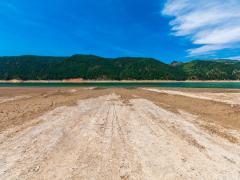New Study Examines Louisiana's 2023 Water Crisis
This article was originally published by Louisiana State University.
In the summer and fall of 2023, South Louisiana faced two simultaneous crises. First, a historic drought trapped residents in crippling heat and caused up to $290 million in agricultural losses.
Second, water levels of the Mississippi dropped so low saltwater began to travel up the river, threatening the water supply in New Orleans and forcing the U.S. Army Corps of Engineers to take measures to block its intrusion.
These dual crises illustrate the difficulties faced by communities on river-dominated coastlines around the world, says a new paper by Louisiana State University (LSU) faculty members Paul Miller and Matt Hiatt, with funding from NOAA's National Integrated Drought Information System (NIDIS), the National Science Foundation, and the U.S. Geological Survey. Miller is an assistant professor in the LSU Department of Oceanography & Coastal Science, and Hiatt is an associate professor.
Not only do these areas have to deal with local weather events, but also the repercussions of conditions thousands of miles away, both on land and in the ocean. “These coastal deltaic cities are finding themselves in the bull’s eye of three different influences,” Miller said.
A new early indicator
In the paper, Miller and Hiatt use a metric known as the Evaporative Demand Drought Index, or EDDI, to quantify drought conditions and examine their relationship to Mississippi River flow.
The EDDI “look[s] at how much moisture the atmosphere is demanding from the landscape,” Miller said, taking into account factors such as low humidity, wind speeds, stronger radiation, higher temperatures, all of which can serve to create higher evaporative demand by the atmosphere.
Using evaporative demand as a lens to view conditions in Louisiana and through the upper Mississippi River basin brought a surprising finding into focus—that low water levels in the Mississippi correlated more closely to EDDI than to precipitation.
Hiatt suggested evaporative demand could become a potential indicator of low water levels in the Mississippi. “Evaporative demand is the biggest explainer of Mississippi River discharge,” he said. “This may be an early indicator for the saltwater intrusion.”
“Intuitively, you would expect that precipitation over the Mississippi River watershed would be the most important indicator of its discharge near New Orleans,” said Miller. It may be that evaporative demand is just easier to link to changes in discharge because of a shorter latency period, he said, whereas precipitation can take up to a few months to reach the lower Mississippi.
“While this same logic could conceivably be applied to evaporative demand as well, it's very interesting that the correlation is more robust to these lag effects,” he continued.
A dire picture
Overall, the paper paints a dire picture of conditions in Louisiana during 2023. After a relatively normal spring, drought conditions began to emerge in early June, and by August, an intense drought had set in across the state, with precipitation well below normal and record-breaking high temperatures, including an average high of 101.9°F in Baton Rouge from August 8 to 29.
EDDI data shows similar drought conditions were in play in the upper part of the Mississippi River basin as well, although to a lesser degree. This led to precipitation over the Mississippi River basin about 5% below average—a relatively small number, the paper notes, but still enough to translate into thousands of cubic meters of lost surface and sub-surface run-off.
Ultimately, an increase in streamflow from upriver spared New Orleans from salt-contaminated drinking water.







